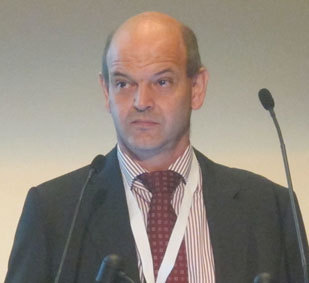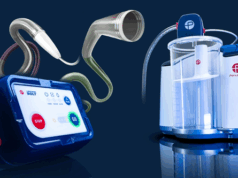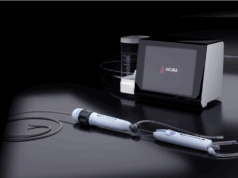
The use of a new fibre for endovenous laser ablation of the great saphenous vein results in equal occlusion rates as achieved with a bare fibre, a new study shows. According to data presented at European Venous Forum (Florence, Italy, 28-30 June 2012), the new tulip-shaped fibre caused less postoperative ecchymosis and pain and patients treated with the device had an increased postoperative quality of life. The results were presented by Marc Vuylsteke, Department of Vascular Surgery Sint-Andriesziekenhuis, Tielt, Belgium.
“Endovenous laser ablation is a very commonly performed technique and has been developed as an alternative to stripping and its possible complications. But endovenous laser ablation also has some side effects such as postoperative ecchymosis, pain, periphlebitis, bruising, paraesthesia and recanalisation. Many of these can be attributed to direct contact with the bare fibre between and the vein wall as this can cause ulcerations, perforations and uneven energy distribution. With that in mind, we developed a tulip-shaped fibre,” he said.
In the tulip fibre, the catheter centres the laser fibre in the vein preventing direct contact with the vein wall. The randomised TULIP clinical trial, which was conducted in two centres in Belgium, aimed to evaluate the clinical results with a tulip fibre versus a bare fibre for endovenous laser ablation. The investigators hypothesised whether a tip design that avoids direct contact of the fibre tip and the vessel wall could avoid these complications.
The inclusion criteria in the study were incompetence of the great saphenous vein and unilateral treatment. The primary endpoints were the possible side-effects of the treatment: the amount of analgesic used, postoperative pain, postoperative ecchymosis, patient satisfaction rate and postoperative quality of life score (CIVIQ2); the secondary endpoint was occlusion rate at one, six and 12 months postoperatively.
One hundred and seventy four patients with great saphenous vein reflux were randomised for one of the two treatments (87/87). Duplex scan were scheduled at one, six and 12 months postoperatively. One year follow-up data were available for 82 patients in the bare fibre group and 85 patients in the tulip fibre group.
“Ecchymosis was measured on the fifth postoperative day. Pain, analgesic requirement, quality of life and patient satisfaction were also noted. The quality of life score assessed pain, physical, psychological and social aspects,” Vuylsteke said.
A 1470nm diode laser was used in the study. The average energy used in patients treated with a bare fibre was on average 63.4J/cm and 59.6J/cm in patients treated with a tulip fibre.
Results
The results showed that patients treated with the tulip fibre had significantly less postoperative ecchymosis (0.04) than those treated with a bare fibre (0.21), p<0.001, and pain assessed on the fifth day after the procedure (1.00 vs. 2.00, p<0.001). The group treated with the tulip fibre also showed increased quality of life (27 vs. 32, p=0.023). There was no difference in anaelgesic intake (p=0.11) and patient satisfaction rate (p=0.564). Some veins that did not close at six months postoperatively closed spontaneously in the following months.
Vuylsteke noted that the total occlusion rate at one year was 97% and that there was no significant difference between the two groups (p=0.309, non-inferiority Newcombe’s test). A significant degree of shrinkage of the veins was noted. At one year for 89.4% of patients with the bare fibre and 85.3% treated with a tulip fibre, the vein had evolved into a fibrotic cord. At one year, new incompetence of the anterior accessory saphenous vein was noted in 12 patients (7.1%), he said.









